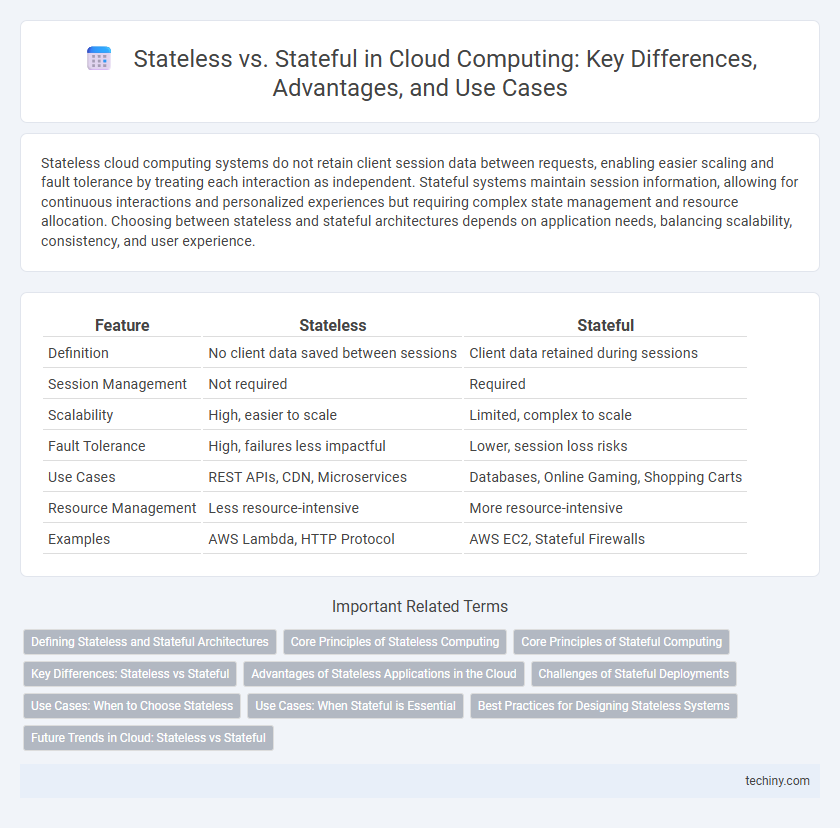Stateless cloud computing systems do not retain client session data between requests, enabling easier scaling and fault tolerance by treating each interaction as independent. Stateful systems maintain session information, allowing for continuous interactions and personalized experiences but requiring complex state management and resource allocation. Choosing between stateless and stateful architectures depends on application needs, balancing scalability, consistency, and user experience.
Table of Comparison
| Feature | Stateless | Stateful |
|---|---|---|
| Definition | No client data saved between sessions | Client data retained during sessions |
| Session Management | Not required | Required |
| Scalability | High, easier to scale | Limited, complex to scale |
| Fault Tolerance | High, failures less impactful | Lower, session loss risks |
| Use Cases | REST APIs, CDN, Microservices | Databases, Online Gaming, Shopping Carts |
| Resource Management | Less resource-intensive | More resource-intensive |
| Examples | AWS Lambda, HTTP Protocol | AWS EC2, Stateful Firewalls |
Defining Stateless and Stateful Architectures
Stateless architectures treat each request as an independent transaction without relying on stored context, enabling effortless scalability and fault tolerance in cloud environments. Stateful architectures maintain client session information across multiple interactions, facilitating personalized experiences but requiring complex state management and resource allocation. Choosing between stateless and stateful designs impacts load balancing, consistency, and recovery strategies in cloud computing deployments.
Core Principles of Stateless Computing
Stateless computing relies on core principles such as independence, where each request is processed independently without retaining client context between sessions. This approach enhances scalability and reliability by eliminating dependencies on stored session information, allowing cloud services to distribute workloads efficiently across multiple servers. Emphasizing idempotency and independent transactions ensures systems maintain consistency and can recover gracefully from failures without complex state synchronization.
Core Principles of Stateful Computing
Stateful computing maintains session information and tracks the state of interactions over time, enabling processes to remember past events and user inputs. Core principles include persistent storage of state data, context-aware processing, and consistent communication across distributed systems to preserve continuity. This approach ensures reliability in applications such as databases, user authentication, and transaction management within cloud environments.
Key Differences: Stateless vs Stateful
Stateless systems do not retain client data between sessions, enabling greater scalability and simpler failover in cloud environments, while stateful systems maintain session information, ensuring consistent interaction for applications requiring continuous context. The key difference lies in data persistence: stateless architectures reset after each request, making them ideal for RESTful APIs, whereas stateful architectures track state across multiple requests, essential for databases and real-time applications. This distinction impacts resource management and fault tolerance, influencing how cloud services handle load balancing and session replication.
Advantages of Stateless Applications in the Cloud
Stateless applications in cloud computing offer enhanced scalability by allowing instances to be added or removed without session dependency, reducing resource contention and enabling efficient load balancing. They simplify fault tolerance and recovery since any instance can handle requests without relying on stored session data, minimizing downtime and improving reliability. This architecture also facilitates continuous deployment and updates, as changes can be rolled out seamlessly without impacting user sessions.
Challenges of Stateful Deployments
Stateful deployments in cloud computing face challenges such as data consistency and synchronization across distributed systems, which complicate scaling and failover processes. Managing persistent storage requires robust backup strategies and latency optimization to ensure application reliability. Ensuring state integrity during updates or crashes demands sophisticated orchestration tools and increased operational complexity.
Use Cases: When to Choose Stateless
Stateless architecture is ideal for applications requiring high scalability and fault tolerance, such as web servers handling numerous concurrent user requests or microservices in cloud-native environments. It excels in scenarios where session data can be stored externally, enabling horizontal scaling and simplified recovery from failures. Choosing stateless design benefits services with unpredictable traffic patterns and those needing rapid deployment and auto-scaling capabilities.
Use Cases: When Stateful is Essential
Stateful computing is essential for applications requiring persistent data storage and session continuity, such as online banking, e-commerce platforms, and healthcare systems that track patient information. Stateful architectures ensure that user interactions and transactions maintain context over time, enabling seamless user experiences and critical data reliability. This contrasts with stateless designs, which are better suited for simpler, scalable workloads without the need for ongoing state retention.
Best Practices for Designing Stateless Systems
Designing stateless systems in cloud computing emphasizes decoupling components to enhance scalability and fault tolerance by avoiding reliance on stored session data. Best practices include externalizing state management to databases or distributed caches, using token-based authentication for user sessions, and ensuring that each request contains all necessary information for processing. Leveraging RESTful APIs and designing idempotent operations further support scalability and simplicity in stateless application architectures.
Future Trends in Cloud: Stateless vs Stateful
Future trends in cloud computing emphasize a growing shift towards stateless architectures to enhance scalability, resilience, and ease of management in distributed environments. Stateful systems will continue to evolve with advanced state synchronization techniques and AI-driven state management to support complex applications requiring persistent data processing. Hybrid models combining stateless microservices with stateful databases are expected to dominate, optimizing performance and flexibility in multi-cloud deployments.
Stateless vs Stateful Infographic

 techiny.com
techiny.com